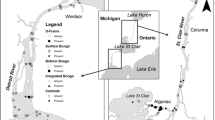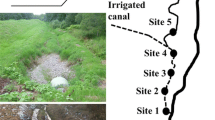Abstract
Migration patterns of Japanese dace Pseudaspius hakonensis in and around Lake Biwa, Japan are unknown, although fluvial–lacustrine life history has been known in most tributaries, the many mature individuals migrating upstream into tributaries in early spring. Field surveys and stable isotope analyses were used to clarify the migratory history of Japanese dace in the Ishida River, inflowing to Lake Biwa. In the field surveys, the number of young of the year (YOY) individuals caught per unit effort (CPUE) by hand net and casting net in the tributary and lake-shore area was calculated. The CPUE peaked from May to July, after the spawning season, thereafter decreasing rapidly, suggesting that YOY Japanese dace migrated downstream to Lake Biwa immediately after emerging, possibly due to the abundant food resources there. From September to November, the CPUE of YOY individuals increased in the lower reaches of the stream, although their stable nitrogen isotope values were variable, in some cases being similar to those recorded in the upper reaches and the lake-shore area. This suggests that some YOY individuals migrate upstream from the lake in autumn. In the present study, the juvenile migration pattern of fluvial–lacustrine Japanese dace in Lake Biwa was described using a CPUE survey and δ15N and δ13C analyses.








Similar content being viewed by others
References
Cabana G, Rasmussen JB (1994) Modeling food chain structure and contaminant bioaccumulation using stable nitrogen isotopes. Nature 372:255–257
DeNiro MJ, Epstein S (1978) Influence of diet on the distribution of carbon isotopes in animals. Geochim Cosmochim Acta 42:495–506
DeNiro MJ, Epstein S (1981) Influence of diet on the distribution of nitrogen isotopes in animals. Geochim Cosmochim Acta 45:341–351
Fujioka Y, Kume H, Kouhashi K, Kikko T, Nishimori K (2020) Long-term fluctuations in spawned egg number and the stock of the ayu fish Plecoglossus altivelis altivelis in Lake Biwa. Report of the Shiga Prefectural Fisheries Experiment Station 56:21–42
Hobson KA (1999) Tracing origins and migration of wildlife using stable isotopes: a review. Oecologia 120:314–326
Howes GJ (1991) Systematic and biogeography: on overview. In: Winfield IJ, Nelson JS (eds) Cyprinid fishes: systematics, biology and exploitation. Chapman and Hall, London, pp 1–33
Ishizaki D, Otake T, Sato T, Yodo T, Yoshioka M, Kashiwagi M (2009) Use of otolith microchemistry to estimate the migratory history of Japanese dace Tribolodon hakonensis in the Kamo River, Mie Prefecture. Nippon Suisan Gakkaishi 75:419–424
Ishizaki D, Yodo T, Yoshioka M (2010) Seaward migration period and size of Japanese dace Tribolodon hakonensis in the Kamo River, Mie Prefecture. Nippon Suisan Gakkaishi 76:920–925
Ishizaki D, Kikko T, Fujioka Y, Mizuno T, Nagata T, Yodo T, Okubo T (2016) The importance of habitat continuity between Lake Biwa and inlet rivers with respect to fish fauna. Japan J Ichthyol 63:89–106
Ito T, Matsumura K, Kozawa G, Ozawa M, Mitsuo Y, Maruyama A, Yuma M (2015) Studying the contribution of two types of landlocked ayu fish in Lake Biwa to the next generation using nitrogen-stable isotope ratio analysis. Ichthyol Res 62:357–362
Kanao S, Kitamura M, Abe T (2002) Fish fauna in the lower region of Inukami river (1988–2001). Biol Inl Wat 17:25–32
Katano O (2007) Effects of experimental duration and density of Japanese dace Tribolodon hakonensis on the strength of trophic cascades on benthic algae. Oecologia 154:195–205
Katano O, Aonuma Y, Nakamura T, Yamamoto S (2003) Indirect contramensalism through trophic cascades between two omnivorous fishes. Ecology 84:1311–1323
Katano O, Uchida K, Aonuma Y (2004) Experimental analysis of the territorial establishment of Ayu, Plecoglossus altivelis. Ecol Res 19:433–444
Katano O, Nakamura T, Abe S, Baba Y (2010) Population density, growth and migration via the sea to different streams of Japanese dace Tribolodon hakonensis in lower reaches of small streams. Ichthyol Res 57:1–9
Kawanabe H (1959) Food competition among fishes in some rivers of Kyoto Prefecture, Japan. Mem Coll Sci, Univ Kyoto, Ser B 26:253–268
Kuwahara M (2018) Biwako no ugui. Walton 7:40–43
Maehata M (2006a) Japanese dace in Ado River. In: Scientific Committee for Research into the Wildlife in Shiga Prefecture (ed) Red data book of Shiga Prefecture of 2005. Sunrise Publishing, Shiga, p 481
Maehata M (2006b) Japanese dace in Ishida River. In: Scientific Committee for Research into the Wildlife in Shiga Prefecture (ed) Red data book of Shiga Prefecture of 2005. Sunrise Publishing, Shiga, p 481
Maki I (1964) The relationship between fishes and their food in a bay of the Lake Biwa, Japan. Seiriseitai 12:259–271
Maruyama A, Yamada Y, Yuma M, Rusuwa B (2001) Stable nitrogen and carbon isotope ratios as migration tracers of a landlocked goby, Rhinogobius sp. (the orange form), in the Lake Biwa water system. Ecol Res 16:697–703
Minagawa M, Wada E (1984) Stepwise enrichment of 15N along food chains: further evidence and the relation between δ15N and animal age. Geochim Cosmochim Acta 48:1135–1140
Mizutani E (1976) The damage of flowing Ayu–fry eaten by various fishes (II) on the contents of stomach of fish in the mouth of artificial spawning cannel and around the spawning grounds of Ayu in Ane River. Rep Shiga Pref Fish Exp Sta 28:21–28
Nakamura M (1969) Cyprinid fishes of Japan: studies on life history of cyprinid fishes of Japan. Research Institute for Natural Resources, Tokyo
Rau GH, Mearns AJ, Young DR, Olson RJ, Schafter HA, Kaplan IR (1983) Animal 13C/12C correlates with trophic level in pelagic food webs. Ecology 64:1314–1318
Sakai H (1995) Life-histories and genetic divergence in three species of Tribolodon (Cyprinidae). Mem Fac Fish Hokkaido Univ 42:1–98
Sakai H (2001) Ugui, Tribolodon hakonensis. In: Kawanabe H, Mizuno N, Hosoya K (eds) Freshwater fishes of Japan, the third edition. Yamatokeikokusha, Tokyo, pp 259–264
Sakai H, Watanabe K, Goto A (2020) A revised genetic taxonomy for Far East Asian minnow Rhynchocypris and dace Pseudaspius. Ichthyol Res 67:330–334
Sawada H, Shigeta K, Kawakami M, Yuma M, Maruyama A (2020) Isotope analysis reveals proportional change and site-selection variation of river- and lake-produced eggs of a landlocked migratory fish. J Fish Biol 96:168–174
Shigaken suisan shikenjyo (1942) Biwako jyuyougyozoku tennenjiryou tyousa houkoku. Shigaken suisan shikenjyo, Shiga
Sotiropoulos M, Tonn W, Wassenaar L (2004) Effects of lipid extraction on stable carbon and nitrogen isotope analyses of fish tissues: potential consequences for food web studies. Ecol Freshw Fish 13:155–160
Yamada Y, Ueda T, Wada E (1996) Distribution of carbon and nitrogen isotope ratios in the Yodo River Watershed. Jpn J Limnol 57:467–477
Yamada Y, Ueda T, Koitabashi T, Wada E (1998) Horizontal and vertical isotope model of Lake Biwa ecosystem. Jpn J Limnol 59:409–427
Yoshida T, Kagami M, Gurung TB, Urabe J (2001) Seasonal succession of zooplankton in the north basin of Lake Biwa. Aquat Ecol 35:19–29
Acknowledgements
We are grateful to Dr. A. Maruyama for technical assistance in the analysis. The sampling of Japanese dace was conducted with the permission of the Fisheries Management Office, Shiga Prefecture. We also thank Dr. G. S. Hardy (Ngunguru New Zealand) for critically reading the manuscript and help with English.
Author information
Authors and Affiliations
Corresponding author
Additional information
Publisher's Note
Springer Nature remains neutral with regard to jurisdictional claims in published maps and institutional affiliations.
About this article
Cite this article
Ishizaki, D., Nagata, T., Kikko, T. et al. Juvenile migration of Japanese dace Pseudaspius hakonensis revealed in a tributary of Lake Biwa with seasonal changes in abundance and stable isotope ratios. Ichthyol Res 68, 496–505 (2021). https://doi.org/10.1007/s10228-021-00804-7
Received:
Revised:
Accepted:
Published:
Issue Date:
DOI: https://doi.org/10.1007/s10228-021-00804-7




